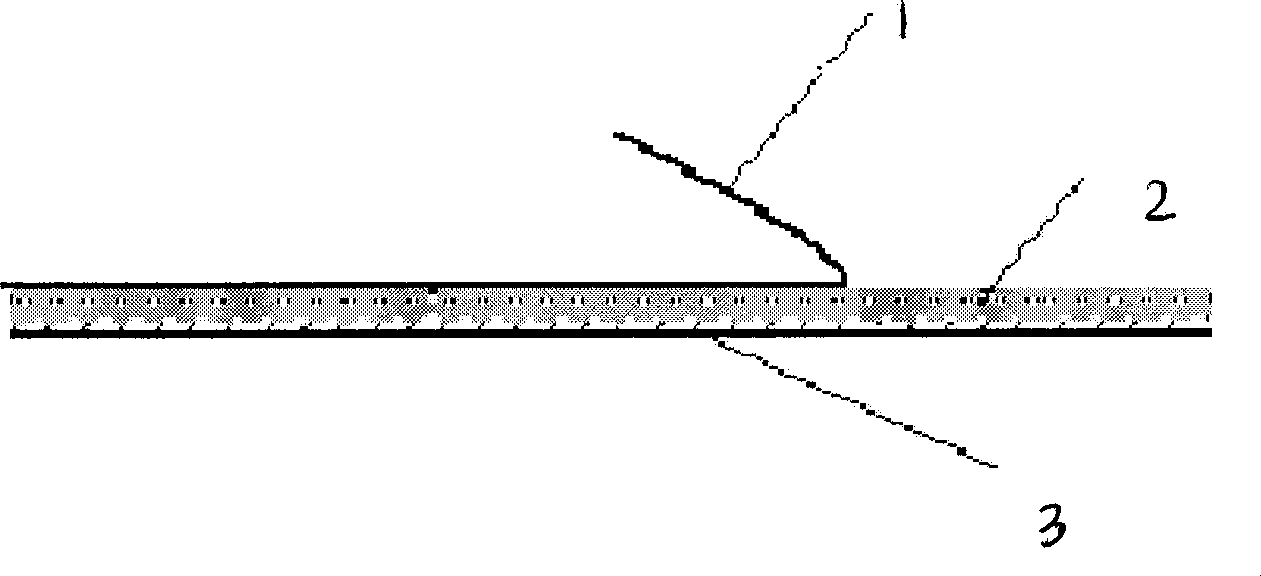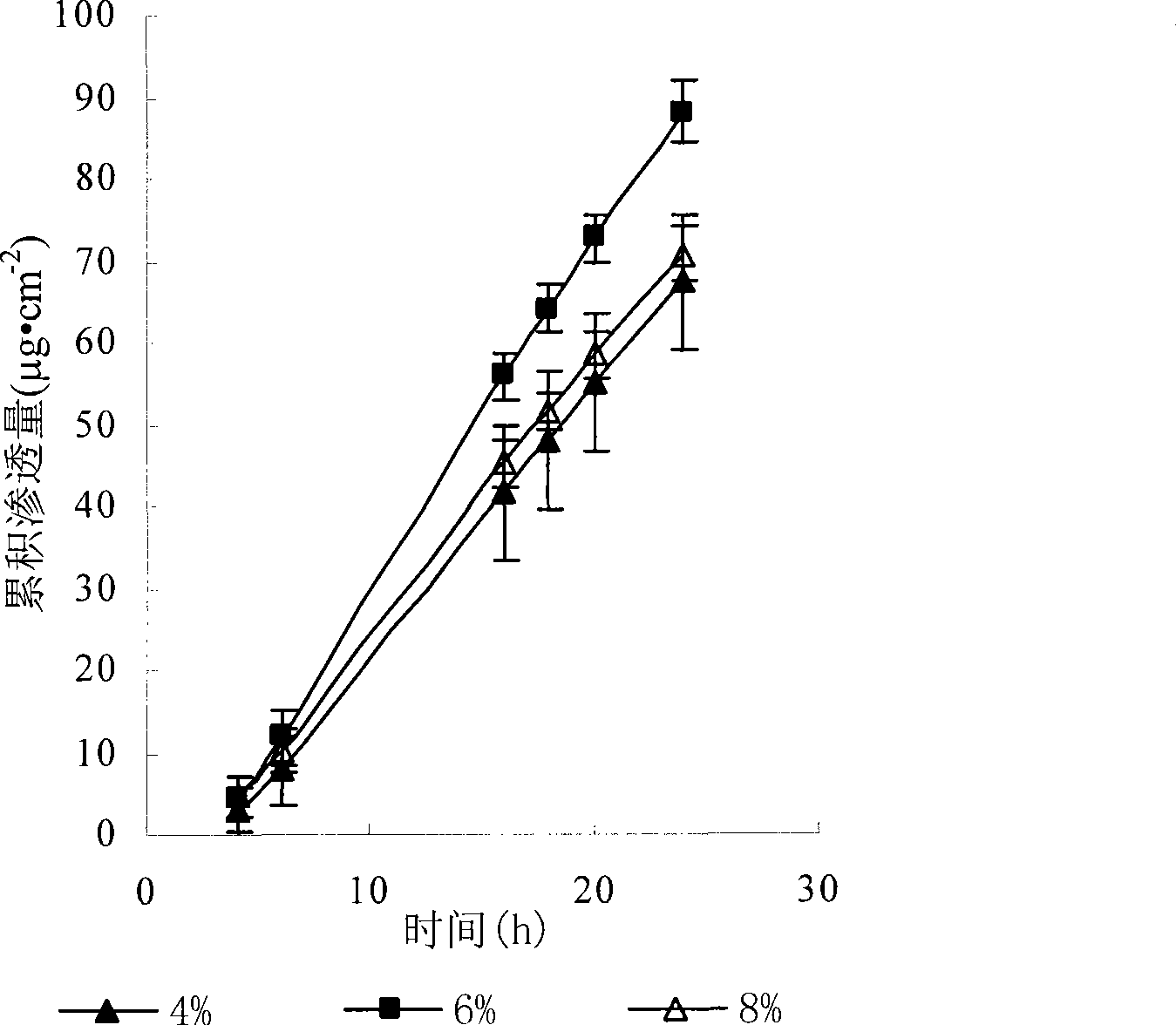Risperidone percutaneous absorption paster
A risperidone and patch technology, applied in the field of pharmacy, can solve the problems of unfavorable long-term treatment of schizophrenia, higher price than oral dosage forms, unfavorable diabetic patients, etc., and achieves prolonging the action time of the drug, convenient storage and transportation, and production. low cost effect
- Summary
- Abstract
- Description
- Claims
- Application Information
AI Technical Summary
Problems solved by technology
Method used
Image
Examples
Embodiment 1
[0038] Polyacrylate pressure-sensitive adhesive 500mg, drug risperidone 50mg, lauryl alcohol 23mg (or 35mg, 48mg), dissolved in ethyl acetate, spread on 100cm 2 On the protective film, dry at 60°C for 30 minutes to remove ethyl acetate, and cover the backing layer after cooling. The dried matrix layer contains 87.3% (or 85.5%, 83.6%) of polyacrylate, 8.7% (or 8.5%, 8.4%) of risperidone, and 4% (or 6%, 8%) of dodecanol. The determination of permeability and risperidone was performed as in the comparative example. image 3 For the cumulative drug penetration-time curve of this example, the penetration rates of the patches with dodecyl alcohol content of 4%, 6% or 8% are 3.37±0.17 μg cm -2 h -1 , 4.28±0.31μg cm -2 h -1 , 3.41±0.30μg cm -2 h -1 .
Embodiment 2
[0040] Polyacrylate pressure sensitive adhesive 500mg, drug risperidone 50mg, lauryl nitrogen Ketone 11.5mg (or 23mg, 35mg, 48mg, 62mg), dissolved in ethyl acetate, spread on 100cm 2 On the backing layer, dry at 60°C for 30 minutes to remove ethyl acetate, and cover with a protective film after cooling. The matrix layer after drying contains polyacrylate 89% (or 87.3%, 85.5%, 83.6%, 82%), risperidone 9% (or 8.7%, 8.5%, 8.4%, 8%), lauryl nitrogen Ketones 2% (or 4%, 6%, 8%, 10%). The determination of permeation rate and risperidone was performed as in the comparative example. Figure 4 Be the drug cumulative penetration-time curve of this embodiment, lauryl nitrogen The penetration rate of patches with ketone content of 2%, 4%, 6%, 8% or 10% was 2.31±0.17 μg cm -2 h -1 , 3.09±0.15μg cm -2 h -1 , 4.27±0.25μg cm -2 h -1 , 3.43±0.11μg cm -2 h -1 , 6.97±0.98μg cm -2 h -1 .
Embodiment 3
[0042] Polyacrylate pressure sensitive adhesive 500mg, drug risperidone 50mg, lauryl nitrogen Ketone 36mg, propylene glycol 24mg (or 37mg, 51mg, 65mg), dissolved in ethyl acetate, spread on 100cm 2 On the protective film, dry at 60°C for 30 minutes to remove ethyl acetate, and cover the backing layer after cooling. The matrix layer after drying contains polyacrylate 82% (or 80%, 78%, 76.8%), risperidone 8% (or 8%, 8%, 7.7%), lauryl nitrogen Ketone 6% (or 6%, 6%, 5.5%), propylene glycol 4% (or 6%, 8%, 10%). The determination of permeability and risperidone was performed as in the comparative example. Figure 5 It is the drug cumulative penetration-time curve of this embodiment, as can be seen from the figure containing 6% lauryl nitrogen The penetration rates of ketone and propylene glycol 4%, 6%, 8% or 10% patches were 4.29±0.17μg·cm -2 h -1 , 5.15±0.01μg cm -2 h -1 , 5.52±0.33μg cm -2 h -1 , 5.24±0.15μg cm -2 h -1 .
PUM
 Login to View More
Login to View More Abstract
Description
Claims
Application Information
 Login to View More
Login to View More - R&D
- Intellectual Property
- Life Sciences
- Materials
- Tech Scout
- Unparalleled Data Quality
- Higher Quality Content
- 60% Fewer Hallucinations
Browse by: Latest US Patents, China's latest patents, Technical Efficacy Thesaurus, Application Domain, Technology Topic, Popular Technical Reports.
© 2025 PatSnap. All rights reserved.Legal|Privacy policy|Modern Slavery Act Transparency Statement|Sitemap|About US| Contact US: help@patsnap.com



